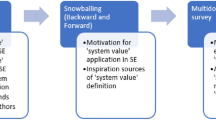Abstract:
This chapter presents seven key elements that provide candidate foundations for value-based software engineering:
-
1.
Benefits Realization Analysis
-
2.
Stakeholder Value Proposition Elicitation and Reconciliation
-
3.
Business Case Analysis
-
4.
Continuous Risk and Opportunity Management
-
5.
Concurrent System and Software Engineering
-
6.
Value-Based Monitoring and Control
-
7.
Change as Opportunity
Using a case study we show how some of these elements can be used to incorporate ethical considerations into daily software engineering practice.
Access this chapter
Tax calculation will be finalised at checkout
Purchases are for personal use only
Preview
Unable to display preview. Download preview PDF.
Similar content being viewed by others
References
ACM/IEEE: The Software Engineering Code of Ethics and Professional Practice. http://www.acm.org, http://www.computer.org (1998)
Ahern, D., Clouse, A., Turner, R.: CMMI Distilled (Addison Wesley, 2001)
Al-Said, M.: Identifying, Analyzing, and Avoiding Software Model Clashes PhD Dissertation (USC, 2003)
Amram, M., Kulatilaka, N.: Real Options (Harvard Business School Press, 1999)
Anderson, R., Johnson, D., Gotterbarn, D., Perolle, J.: Using the New ACM Code of Ethics in Decision Making (Comm. ACM, February 1993), pp 98–105
Baird, R., Ramsower, R., Rosenbaum, S.: Cyberethics (Prometheus Books, 2000)
Baldwin, C., Clark, K.: Design Rules: The Power of Modularity (MIT Press, 2000)
Boehm, B. W., Turner, R.: Balancing Agility and Discipline (Addison Wesley, 2004)
Boehm, B. W., Port, D., Al-Said, M.: Avoiding the Software Model-Clash Spiderweb (Computer, 2000), pp 120–122
Boehm, B. W., Port, D., Jain, A., Basili, V.: Achieving CMMI Level 5 Improvements with MBASE and the CeBASE Method (Cross Talk, 2002)
Boehm, B. W., Port, D., Huang, L., Brown, A. W.: Using the Spiral Model and MBASE to Generate New Acquisition Process Models: SAIV, CAIV, and SCQAIV (Cross Talk, 2002)
Boehm, B. W. and Huang, L.G.: Value-based Software Engineering: A Case Study, IEEE Computer, March 2003 pp 33–41
Boehm, B. W., Port, D.: Balancing Discipline and Flexibility with the Spiral Model and MBASE (Cross Talk, 2001)
Boehm, B. W., Ross, R.: Theory-W Software Project Management: Principles and Examples (IEEE Transactions on Software Engineering, 1989), pp 902–916
Carr, D.: Sweet Victory (Baseline, 2002)
Cohen, L.: Quality Function Deployment (Prentice Hall, 1995)
Collins, W., Miller, K., Spielman, B., Wherry, J.: How Good is Good Enough? (Comm. ACM, 1994), pp 81–91
Cusumano, M., Selby, R.: Microsoft Secrets, How the World’s Most Powerful Software Company Creates Technology, Shapes Markets, and Manages People (The Free Press, 1995)
Ehn P. (ed): Work-Oriented Design of Computer Artifacts (Lawrence Erlbaum Assoc., 1990)
Ermann, M. D., Shauf, M.: Computers, Ethics, and Society 3 (Oxford U. Press, 2003)
Federal Aviation Administration (FAA): The Integrated Capability Maturity Model (1997)
Faulk, S., Harmon, D., Raffo, D.: Value-Based Software Engineering (VBSE): A Value-Driven Approach to Product-Line Engineering. Proceedings, First International Conference on Software Product Line Engineering (August 2000)
Highsmith, J.: Adaptive Software Development (Dorset House, 2000)
Highsmith, J.: Agile Software Development Ecosystems, (Addison Wesley, 2002)
Jacobson, I., Booch, G., Rumbaugh, J.: The Unified Software Development Process (Addison Wesley, 1999)
Johnson, D., Nissenbaum, H.: Computers, Ethics, and Social Values (Prentice Hall, 1995)
Kaplan, R., Norton, D.: The Balanced Scorecard: Translating Strategy into Action (Harvard Business School Press, 1996)
Kauffman, S.: At Home in the Universe (Oxford University Press, 1995)
Kruchten, P.: The Rational Unified Process 3 (Addison Wesley, 2001)
Paulk, M., Weber, C., Curtis, B., Chrissis, M.: The Capability Maturity Model (Addison Wesley, 1994)
Parnas, D.: Designing Software for Ease of Extension and Contraction (IEEE Transactions on Software Engineering, 1979), pp 128–137
Rawls, J.: A Theory of Justice (Belknap/Harvard U. Press, 1971)
Reifer, D.: Making the Software Business Case (Addison Wesley, 2002)
Royce, W. E.: Software Project Management (Addison-Wesley, 1998)
Morton, M. S.: The Corporation of the 1990s: Information Technology and Organization Transformation (Oxford University Press, 1991)
Software Engineering Institute (SEI): Capability Maturity Model Integration (CMMI), Version 1.1 (CMU/SEI-2002-TR-012, 2002)
Software Productivity Consortium (SPC): The Evolutionary Spiral Process. SPC Technical Report (Herndon, VA, 1992)
Sullivan, K., Cai, Y., Hallen, B., Griswold, W.: The Structure and Value of Modularity in Software Design. Proceedings, ESEC/FSE, 2001 (ACM Press, 2001), pp 99–108
Thorp, J., DMR: The Information Paradox (McGraw Hill, 1998)
Author information
Authors and Affiliations
Editor information
Editors and Affiliations
Rights and permissions
Copyright information
© 2006 Springer-Verlag Berlin Heidelberg
About this chapter
Cite this chapter
Boehm, B.W. (2006). Value-Based Software Engineering: Seven Key Elements and Ethical Considerations. In: Biffl, S., Aurum, A., Boehm, B., Erdogmus, H., Grünbacher, P. (eds) Value-Based Software Engineering. Springer, Berlin, Heidelberg. https://doi.org/10.1007/3-540-29263-2_6
Download citation
DOI: https://doi.org/10.1007/3-540-29263-2_6
Publisher Name: Springer, Berlin, Heidelberg
Print ISBN: 978-3-540-25993-0
Online ISBN: 978-3-540-29263-0
eBook Packages: Computer ScienceComputer Science (R0)




